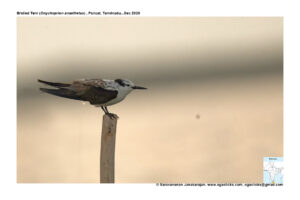
Bridled Tern Onychoprion anaethetus
Etymology:
- Onychoprion : Greek word onux –claw, nail; prion-saw
- Anaethetus : Greek word anaisthetos – stupid, senseless.
Vernacular Names: Guj: Badami pankh vabagali, Mar: Lagam suray
Distribution: Size of 35–38 cm; 95–150 g; wingspan 76–81 cm. It is semi-pelagic tern with long, deeply forked tail and long, narrow wings; forehead patch is white and triangular, extending short way behind eye. The crown and nape are black, occasionally with narrow paler hindneck collar. The upperparts are dark grey-brown, paler on rump and tail, with white outer tail feathers. The upperwing is dark grey-brown, with conspicuous pale leading edge. It is whitish below, with grey breast. The bill and legs are black. Non-breeding adult is somewhat paler, crown and nape have whitish and brownish streaks, reducing conspicuousness of white eyebrow. The juvenile has white forehead and supercilium and blackish brown hindneck, with crown and nape streaked grey and white; dark brown above, with broad whitish scaling, dark brown flight-feathers. Immature is paler brown, with white-edged feathers, crown is brown and speckled with grey, black head pattern more obscure.
Habitat: It is pantropical, occurring on tropical and subtropical coasts. It breeds on coral beaches and rocky and sandy slopes. It forages inshore and offshore. It perches on floating objects and on trees at night; also roosts on sandbanks or rocky beaches.
Food habits: It eats surface-schooling fish, squid ,crustaceans and aquatic insects. It feeds by plunge-diving without submerging, or contact-dipping and by surface-dipping or aerial-dipping. Specializes on foraging over poorly productive (oligotrophic) continental shelf waters, avoiding competition with other terns. It is attracted to masses of drifting seaweed and perches on flotsam, feeding on a range of organisms.
Breeding habits: They breed in May–June in the Caribbean and W Africa, May/June–August in the Red Sea and Africa, July–August in Madagascar, October–December in Australia. They breed in colonies of 3–20 pairs. The nests are often distributed in vegetation, rock or rubble around rim of an island, rather than clustered. Most of them retain nest-sites from year to year, even with different mates. The nest contents are normally concealed under a rock or vegetation, or in abandoned Crab Plover burrows, reducing predation. They lay a clutch of 1 egg. The incubation period is 27–33 days. The chicks are finely mottled. The fledging period is 50–65 days. The dependent young remain around colony a further 30–35 days.